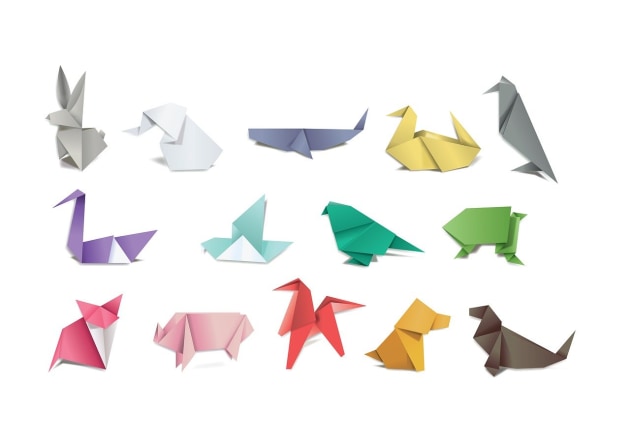



Origami is a kind of paper art that became widely popular in Japan. The name ‘origami’ combines ‘ori’ (which means to fold) and ‘kami’ (which means paper), which perfectly describes what origami is. It involves folding a flat sheet of paper multiple times to create unique shapes and sculptures.
Origami creations often resemble plants and animals, particularly lotus flowers and cranes. However, people have created origami in just about any shape you can imagine!
Origami has been around for a lot longer than you might think, but it wasn’t always called ‘origami’. In fact, this form of art has been known by all sorts of different names, including ‘orikata’ and ‘orimono’.
Because paper is such a fragile material, there isn’t a lot of evidence of origami from the past that we can look back on. However, it’s widely believed that the art of paper folding has its roots in China. Paper was invented in China around the year 105, and Chinese people had their own traditions of folding paper into shapes. For instance, paper would be folded into the shape of ingots to be used at traditional funerals.
Paper was first introduced to Japan during the seventh century, and over time, Japanese people improved on their technique to create a more durable kind of paper known as washi. Originally, paper was a commodity that only wealthier people could afford and origami was only practised during special ceremonies.
But in the 1600s, when paper manufacturing rapidly expanded, paper became accessible to a much wider section of Japanese society. People used origami for creating things such as envelopes and gift wrappers, and books from this era even show instructions for making early origami.
Meanwhile, in Europe, a different paper-folding tradition was starting to take hold. Napkin folding was popular in Europe in the 17th century, and although it eventually fizzled out, paper folding techniques found their way into schools thanks to a man called Friedrich Fröbel.Fröbel, who also came up with the idea of the kindergarten, designed paper folding techniques that could be used in schools.
As Japan opened up to the world during the 1800s, they incorporated parts of Fröbel’s system into traditional Japanese origami. Since then, origami has evolved into what we know it to be today, with a huge variety of new techniques and designs!
Even though it’s an old art form, origami is still widely popular both in Japan and the whole world over. Origami practitioners still continue to create incredible sculptures with just a few sheets of paper, and it’s easier than ever to buy instruction manuals to get started with origami yourself.
Not only that, but there are also several styles and variations of origami. While origami purists might say that true origami doesn’t include glue or cutting the paper, there are plenty of variations that do incorporate these techniques. These include kirigami, which incorporates both cutting and folding into the finished piece. Some origami artists now also use a technique called wet-folding, where water is applied to the paper to make it easier to shape.
Origami can be intricate and complicated, but it doesn’t have to be - you can create something beautiful even with just a few folds. Here are a few easy origami activities that either you or your children could have a crack at:
A classic that many people will recognise straight away, cranes are a great starting place when it comes to easy origami for kids. In Japanese culture, cranes are seen as symbols of good luck, fortune and a long life. In fact, there’s even a saying which states that a person will have their wish granted if they make a thousand origami cranes (called ‘senbazuru’).
If you’re looking for easy origami, then you won’t go wrong with these great instructions for origami butterflies. These paper butterflies can be made with just a few careful folds of some square paper. What’s more, you or your children can decorate them or use different coloured paper to make each one unique.
When it comes to easy origami for kids, you won’t do much better than this lotus flower craft. The lotus flower holds a great deal of meaning in Japanese culture, and making your own paper versions can be a good opportunity to learn about its rich symbolism.
With just a few folds, you or your children can create an adorable canine companion for your desk. This makes it the ultimate easy origami for kids, and they can even decorate their pups afterwards using coloured pens or pencils.
If you’d like some more origami activities to engage your learners, then we’ve got plenty more for you to pick from. Our collection of Origami Crafts contains instructions for origami whales, koalas, snakes and much more!
For some learners, written instructions can feel a bit unclear and difficult to follow. That’s why we’ve even gone to the effort of making some brilliant video tutorials that they can follow instead. That way, children can see each and every fold in real time.
To learn more about what we’ve got to offer, you can give this handy video a watch!